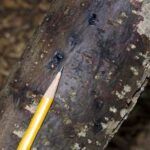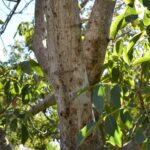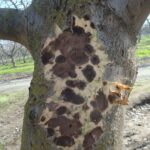Thousand Cankers Disease
Thousand Cankers Disease is a plant disease caused by the fungus Geosmithia morbida, which is spread by the walnut twig beetle. The disease affects several species of walnut trees, including black walnut, English walnut, and other varieties of walnut. The disease is primarily found in the western United States, including California, Oregon, and Arizona, but it has also been reported in several eastern states.
The disease gets its name from the characteristic small cankers that form under the bark of the tree, each caused by a single beetle. As more beetles infest the tree and create more cankers, the tree becomes weakened and eventually dies. Symptoms of the disease include yellowing leaves, wilting, and canopy thinning.
The walnut twig beetle, which carries the fungus, is native to the southwestern United States and Mexico, but it has spread to other parts of the country. The beetles bore into the tree and create small tunnels where they lay their eggs. The fungus is introduced into the tree through the holes made by the beetles.
Preventing the spread of Thousand Cankers Disease is difficult, as there is no cure for infected trees. The best way to prevent the disease from spreading is to limit the movement of infested walnut wood, as the beetle can hitchhike on firewood or other wooden items. Some states have implemented quarantines to limit the transport of walnut wood.
Research is ongoing to develop strategies to manage and control the disease. One approach is to identify and breed resistant varieties of walnut trees. Another is to develop methods to detect and remove infected trees before the disease can spread to healthy trees. Additionally, insecticide treatments have been used to control the walnut twig beetle, but their effectiveness is still being studied.
Overall, Thousand Cankers Disease is a serious threat to walnut trees and the industries that depend on them. Continued research is needed to find effective solutions for managing and controlling the disease.






